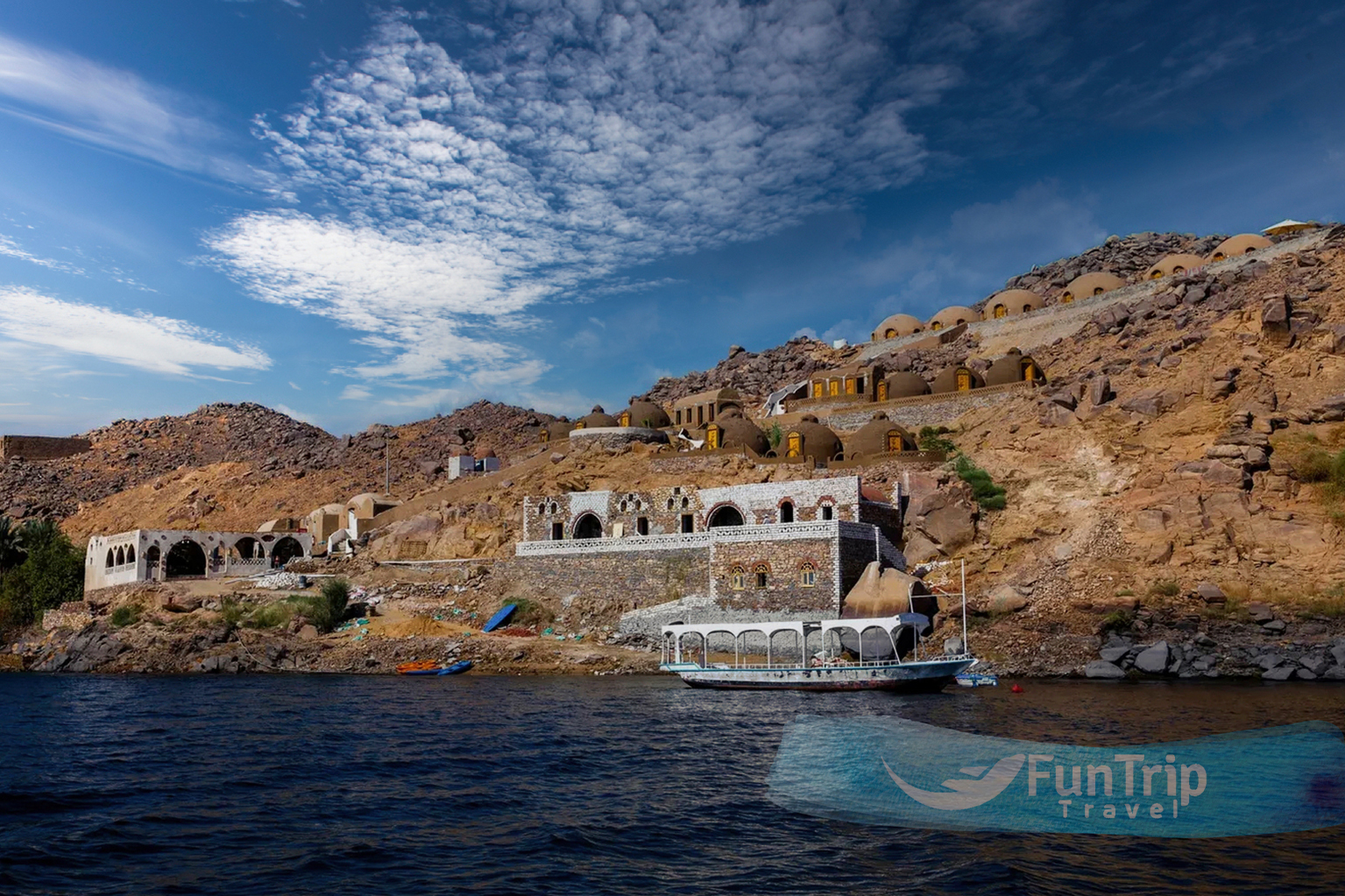Aswan city is one of the most enjoyable places to spend a vacation in Egypt, with beautiful views of the broad Nile River meeting the desert and a relaxed atmosphere, as well as many hot islands for bird-watching tourism. Aswan has drawn visitors from all over the world since the nineteenth century. The Agha Khan Mausoleum, the Nubian Museum, the Aswan Museum, the Temple of Kalabsha, the High Dam, Kitchener’s Island, the Philae Temple, and the Unfinished Obelisk were all located there.
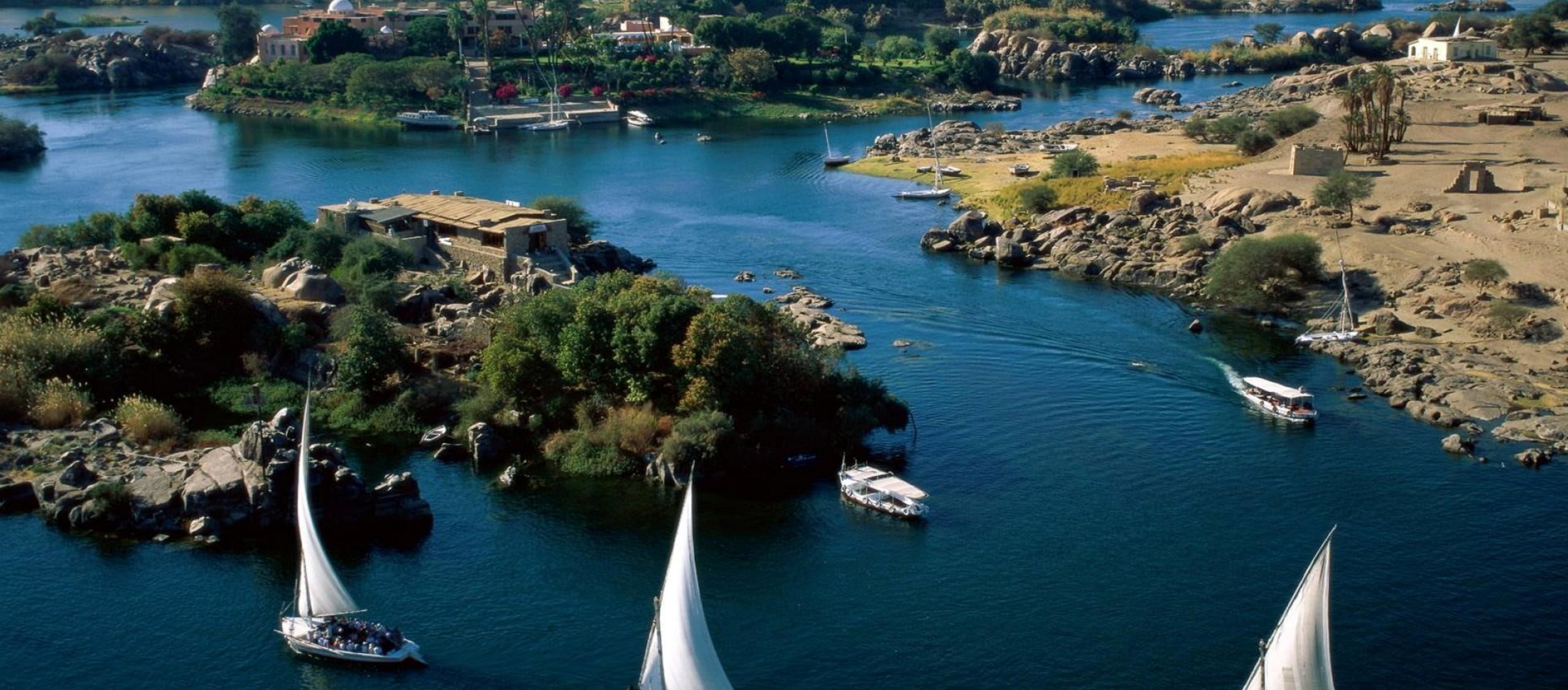
EXPLORE. CONNECT. CREATE MEMORIES
Elephantine Island
Elephantine Island’s southern tip contains the ancient Abu site. Its name in ancient Egyptian meant both “elephant” and “ivory,” a reminder of the island’s importance in the ivory trade. The Nubian villages of Siou and Koti on the island provide an unexpected contrast to the hustle and bustle of the city across the water. The island is located just north of the First Cataract, opposite central Aswan. A recent building boom has altered its character, but it remains peaceful and primarily rural. To establish Egypt’s southern border at the start of the first dynasty (around 3000 BC), a fortress was built on the island. Abu quickly grew in importance as a customs point and trading center. Throughout the Pharaonic period, it served as a strategic departure point for military and commercial expeditions into Nubia and the south. During the 6th dynasty (2345-2181 BC), Abu became an important political and economic center, and despite ups and downs, the island remained significant until the Graeco-Roman period. Elephantine Island was the main cult center of the ram-headed god Khnum (at first the god of inundation, but from the 18th dynasty worshipped as the creator of humankind on his potter’s wheel), Satet, Khnum’s consort and guardian of the southern frontier, and his other consort Anuket, goddess of nearby Sehel. Every year, the rushing of the flood waters was first heard here on Elephantine Island. As religious complexes took over more and more of the island, residential areas moved either north or east of the island. When Christianity was established as the imperial Roman religion in the 4th century AD, the temple town of Abu received its coup de grâce. Worship of the ancient gods was gradually abandoned after that, and defensive fortifications were relocated to the east bank, which is now the city of Aswan. The villages of Siou and Koti are located between the ruins in the south and the Mövenpick Resort, which occupies the entire northern end of the island. A north-south path runs through the middle of the island, connecting the two villages. Baaba Dool, a gorgeous painted Nubian house facing Kitchener’s Island close to the wall separating the Mövenpick Resort from Siou village, serves tea, sells Nubian handicrafts, and can arrange live music and dancing performed by local women. The roof terrace is ideal for watching the sunset on the west bank, with a plethora of birds flying around the island opposite. Animalia, a charming Nubian museum, is also located in the villages.

Ruins of Elephantine
View towards Khnum ruins on Elephantine Island, Aswan, Upper Egypt, Egypt, North Africa, AfricaElephantine Island’s southern tip is home to the evocative ruins of ancient Abu and the Aswan Museum (partially closed for renovations). From around 3000 BC to the 14th century AD, the island’s long history is commemorated by numbered plaques and reconstructed buildings. The Temple of Khnum, which has been partially rebuilt, is the largest structure on the site (plaque numbers 6, 12 and 13). Built in the Old Kingdom in honor of Khnum, the god of inundation, it was used for over 1500 years before being extensively rebuilt in Ptolemaic times. Other highlights include a small 4th-dynasty step pyramid (number 15), reconstructed from the Temple of Kalabsha (which is now just south of the High Dam); a reconstructed 18th-dynasty temple (number 2), built by Hatshepsut (1473-1458 BC) and dedicated to the goddess Satet; and a cemetery for sacred rams (number 11), thought to have been the living embodiment of the goddess Satet. The Nilometer of the Temple of Khnum, is located beneath the temple’s southern balustrade. Aside from divine foretelling and priestly prophecies, only a Nilometer could accurately predict the likelihood of a bountiful harvest in ancient times. The Nilometer of Khnum, built during the 26th dynasty, has stone stairs leading down to a small basin for measuring the Nile’s maximum level. When the nilometer in this southern frontier town recorded a high river level, it meant a good harvest, which meant more taxes. Another stairway, with a scale etched into its wall, leads from the basin’s northern end to the water. The Nilometer of the Satet Temple, number 10, descends the river’s edge from beneath a sycamore tree near the Aswan Museum. Its staircase is roofed over, and niches in the walls would have had oil lamps to provide light. It was built in late Ptolemaic or early Roman times and restored in the 19th century. You can see the names of Roman prefects carved into the left-hand wall as you descend to the river if you look closely.
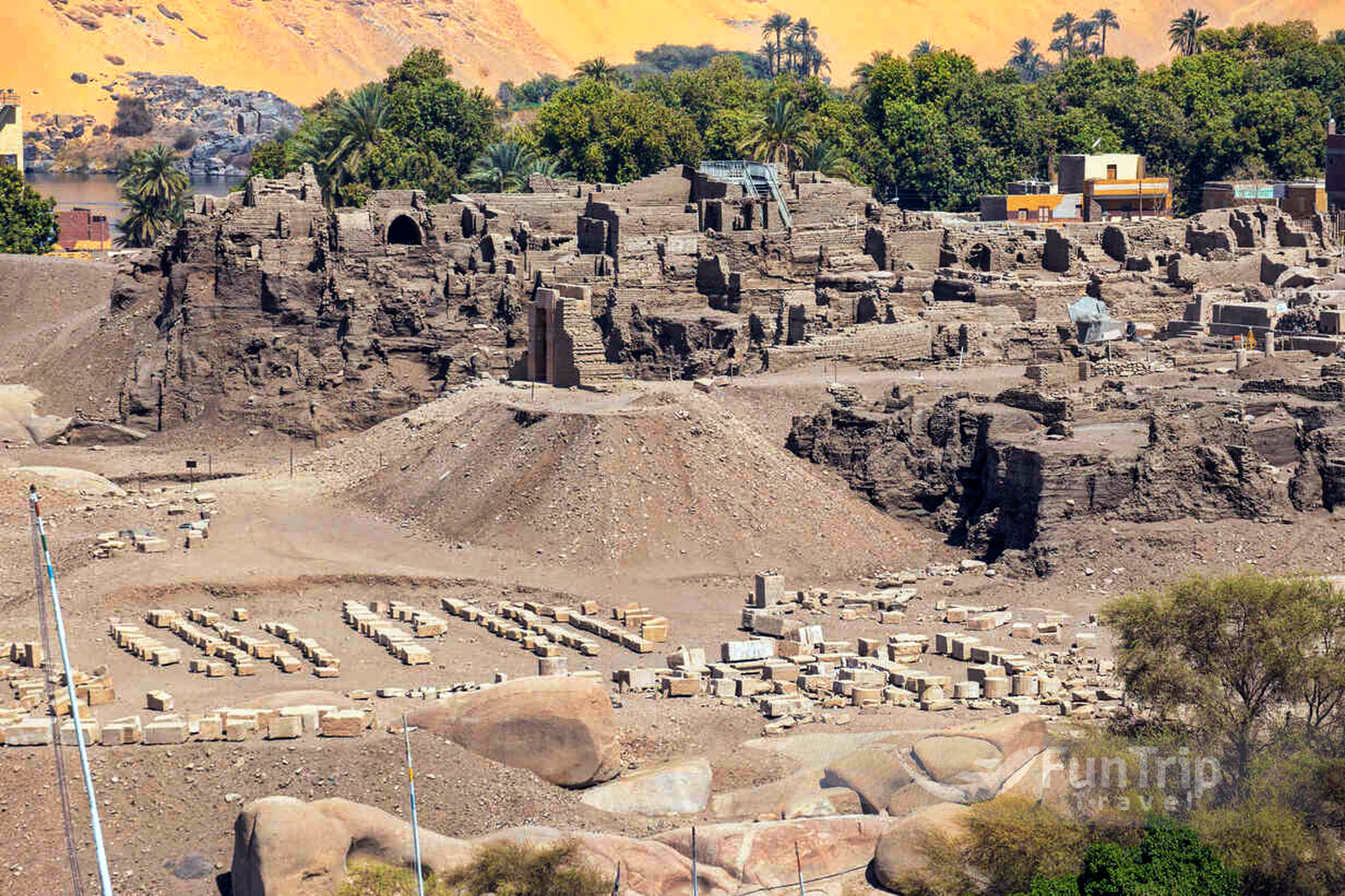
The Botanical Island (The Botanical Garden)
The 75 meters long Botanical Island, one of Aswan’s biggest islands,has a variety of exotic plants and trees, such as Sabal Palm trees and Royal Palm trees.
The Botanical Island is popular with both tourists and locals. It allows them to get away from the busy city and enjoy a relaxing environment filled with greenery and quiet.
The Nubians settled in Aswan Botanical Garden, which they called Jet Narty. Lord Horatio Kitchener took the island in 1899 to be a resting place for his campaign and named it the Lord’s House. Lord Kitchener was an Egyptian Army commander. Kitchener, who had a deep love of palm trees and plants, transformed the entire Kitchener’s Island into a stunning botanic garden. Later, the Egyptian government reclaimed the island, which is now known as the Aswan Botanical Gardens.
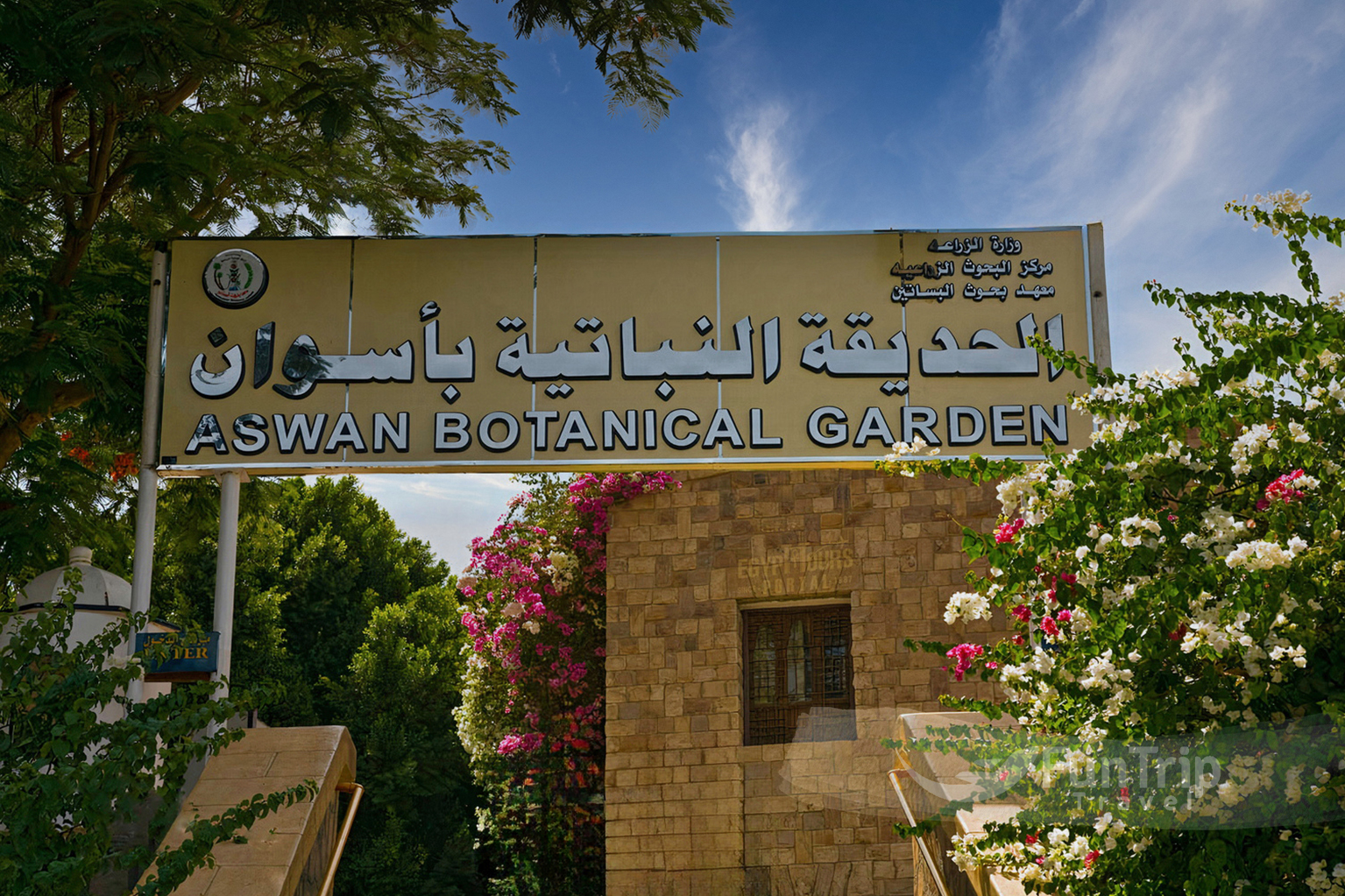
Seheyl
The Most Amazing Island In Aswan
The island of Seheylwas sacred to the goddess Anuket and was located just north of the old Aswan Dam. Prior to the dam’s construction, the Nile would rush noisily through the granite boulders that emerged from the riverbed just south of here, forming the First Cataract. A cliff on the island’s southern tip bears more than 200 inscriptions, the majority of which date from the 18th and 19th dynasties, of princes, generals, and other officials who passed through on their way to Nubia. The most famous of these inscriptions is the so-called famine stele from the third dynasty, which recounts a terrible seven-year famine during Zoser’s (2667-2648 BC) reign, which the pharaoh attempted to end by making offerings to the Temple of Khnum on Elephantine Island. A friendly Nubian village with brightly colored houses is located next to the inscriptions. An Egyptian official told Herodotus that the First Cataract was the source of the Nile, which flowed north and south from there. Now that the waters are flowing more slowly.
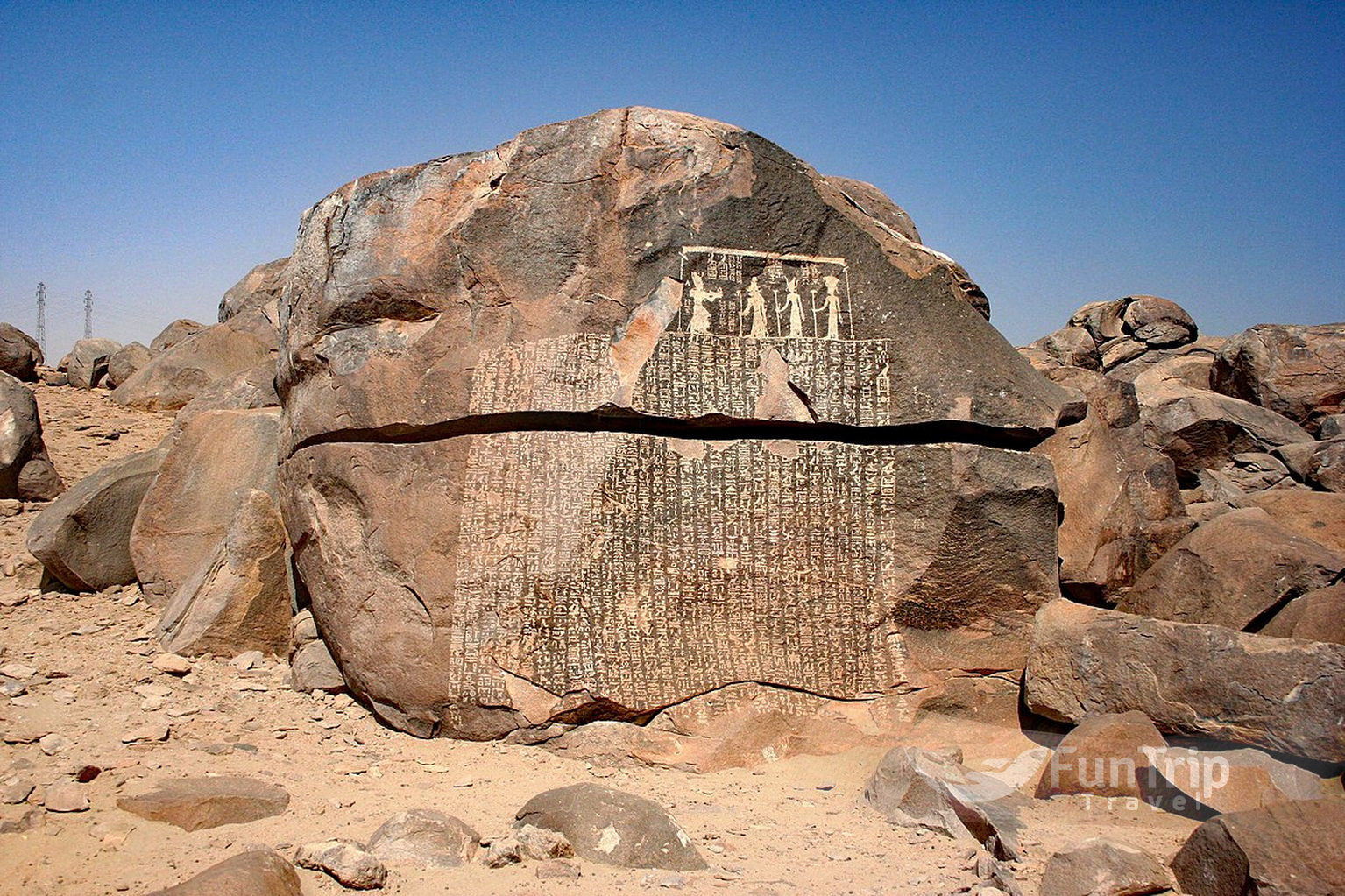
Gharb Seheyl
The village opposite Seheyl Island has recently become a popular tourist attraction, both for Aswan excursions and for those seeking a slower pace of life. The colorful Nubian houses are a sight to behold, and there is a nearby beach for safe swimming, camel rides, and a small Nubian crafts souq. It is a popular stop for a few relaxing days due to its selection of laid-back guesthouses. Check out the Fun Trip package.
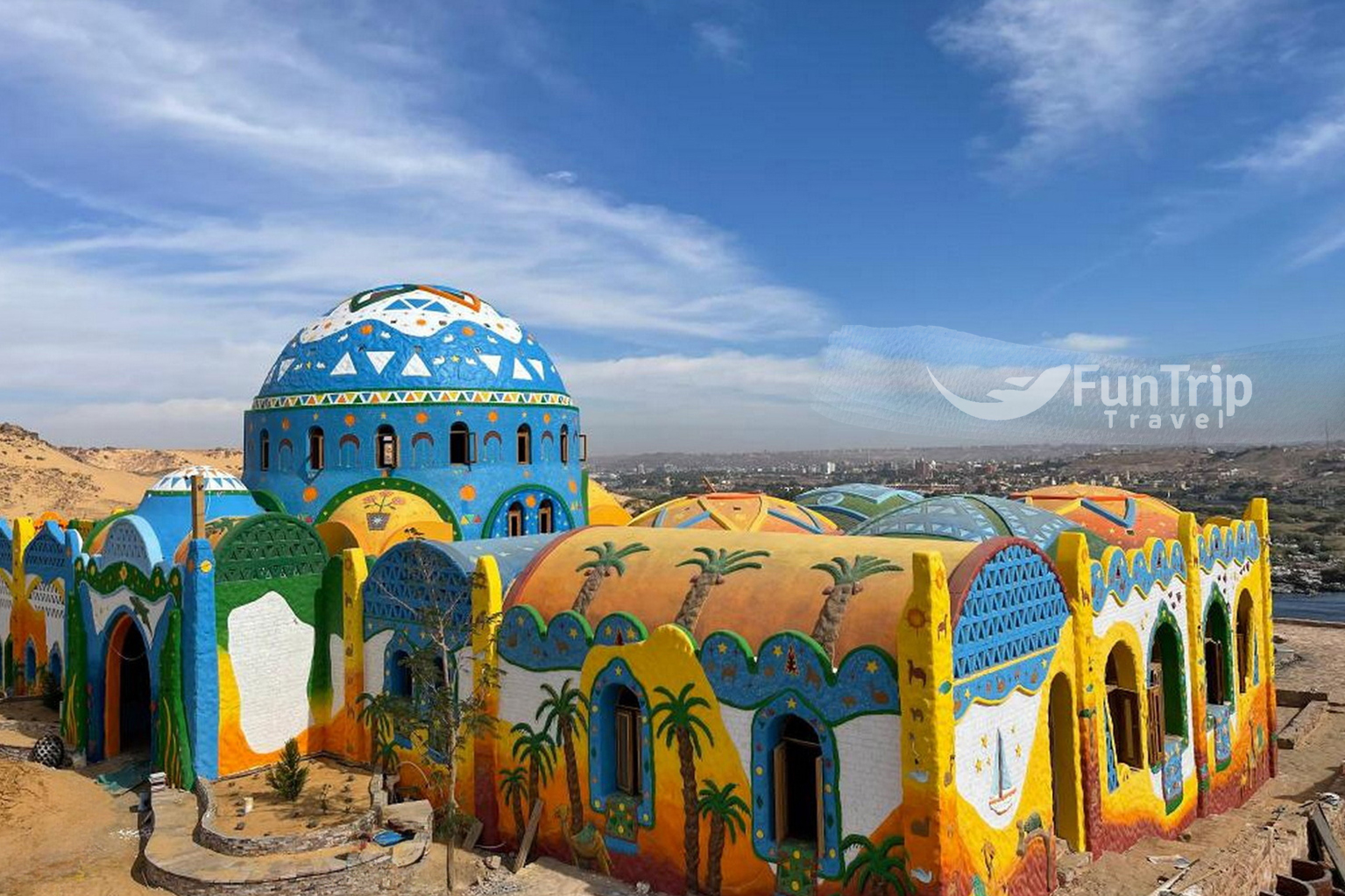
Felucca sailing
The best way to travel on the Nile River is by felucca, a traditional wooden sailboat of Egypt. Egyptians have sailed on this wooden sailboat for hundreds of years to cross the Nile River and travel to various points from it. Because there is no engine on the boat, the winds and currents propel it to its destination. You will feel like an ancient Egyptian while sailing the Nile on the felucca.
You will feel relaxed as you sail the Nile River. The only sounds you will hear come from the sails themselves. Meanwhile, you’ll get a beautiful view of the Nile riverbanks as you sail on the water. It is truly a memorable experience that you need to see to appreciate. There are several felucca tours available which last anywhere between 1 hour to 12 hours, depending on how much you want to see the countryside. If you’re feeling very adventurous, then you can travel to Luxor on a 3-day journey.

The Nubian life
Consider paying a visit to a Nubian house, for many Nubian families are eager to host tourists in order to supplement their income. It’s a fantastic way to learn about their culture and see how they live. Some of the families also sell handmade traditional accessories and prepare traditional food for tourists.
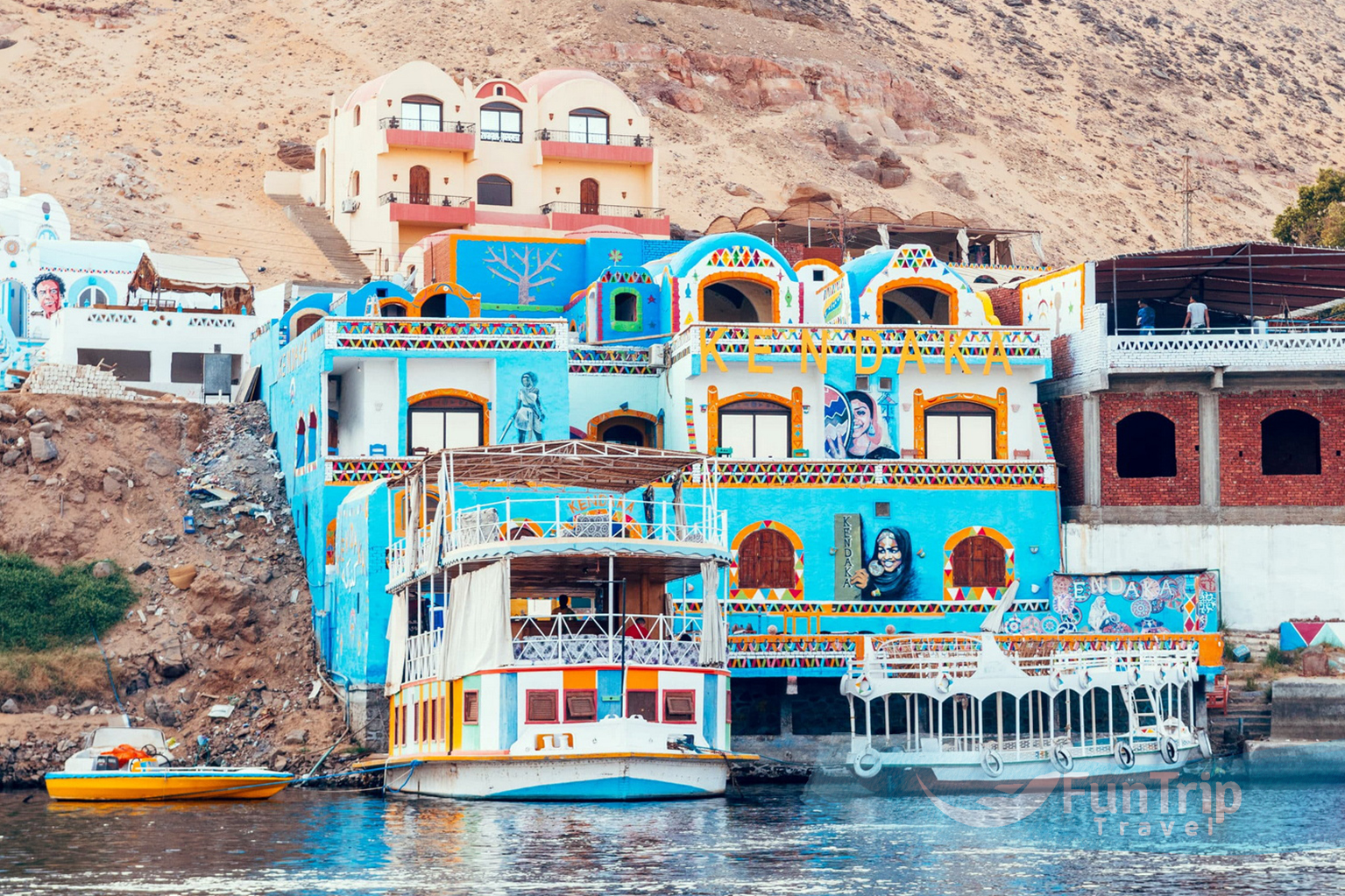
Nubia Museum
Established by UNESCO in Egypt to display the wonderful historical findings all around Nubia from prehistoric eras to contemporary times, is a treat, a showcase of Nubia’s history, art, and culture. The museum, which opened in 1997 in collaboration with UNESCO, serves as a reminder of what was lost beneath Lake Nasser. Exhibits are beautifully displayed in large halls with clear written explanations that take you from 4500 BC to the present day.
The exhibits begin with prehistoric artefacts and objects from Kush and Meroe. Following the construction of the Aswan High Dam, a description of the massive Unesco project to relocate Nubia’s most important historic monuments away from the rising waters of Lake Nasser follows.
6000-year-old painted pottery bowls and an impressive quartzite statue of a 25th-dynasty priest of Amun in Thebes with distinct Kushite (Upper Nubian) features are among the museum’s highlights. The exquisite horse armor discovered in tombs from the Ballana period (5th–7th centuries BC) demonstrates the sophistication of artisanship during this brief reign. A fascinating exhibit traces the history of irrigation along the Nile, from the earliest attempts to control the flow of the river to the construction of the old Aswan Dam. A model of a Nubian house, complete with antique furniture and mannequins wearing traditional silver jewellery, attempts to depict modern Nubian folk culture.

Aswan Museum
The older section of the Museum is housed in the villa of Sir William Willcocks, the old Aswan Dam engineer. The villa was built in 1898 and became a museum in1912. The more recent extension was added in 1998.
The Museum primarily houses antiques from Aswan and Nubia, despite the fact that many Nubian artefacts recovered from temples destroyed by Lake Nasser were transferred to the Museum of Nubia. The Museum’s new annex houses a vast collection of objects gathered from Elephantine Island excavations, including statues, weapons, pottery, and utensils, as well as encased mummies and sarcophagi dating from predynastic to late Roman times. The objects are properly displayed, with labels in Arabic and English, and are arranged in separate glass cases, each illustrating a different ancient aspect of life on the island: hunting, religion, death, trade, weaving, farming, cooking, artistry, and so on.
The mummy and a sarcophagus, as well as a sacred ram, an animal associated with Khnum, are located to the right of the Museum’s main entrance, which is a chamber in and of itself. A path behind the Museum leads across the garden to a resemblance of ancient Abu. Plaques with numbers and restored monuments adequately reflect the island’s long history from around 3000 BC to the 14th century AD.
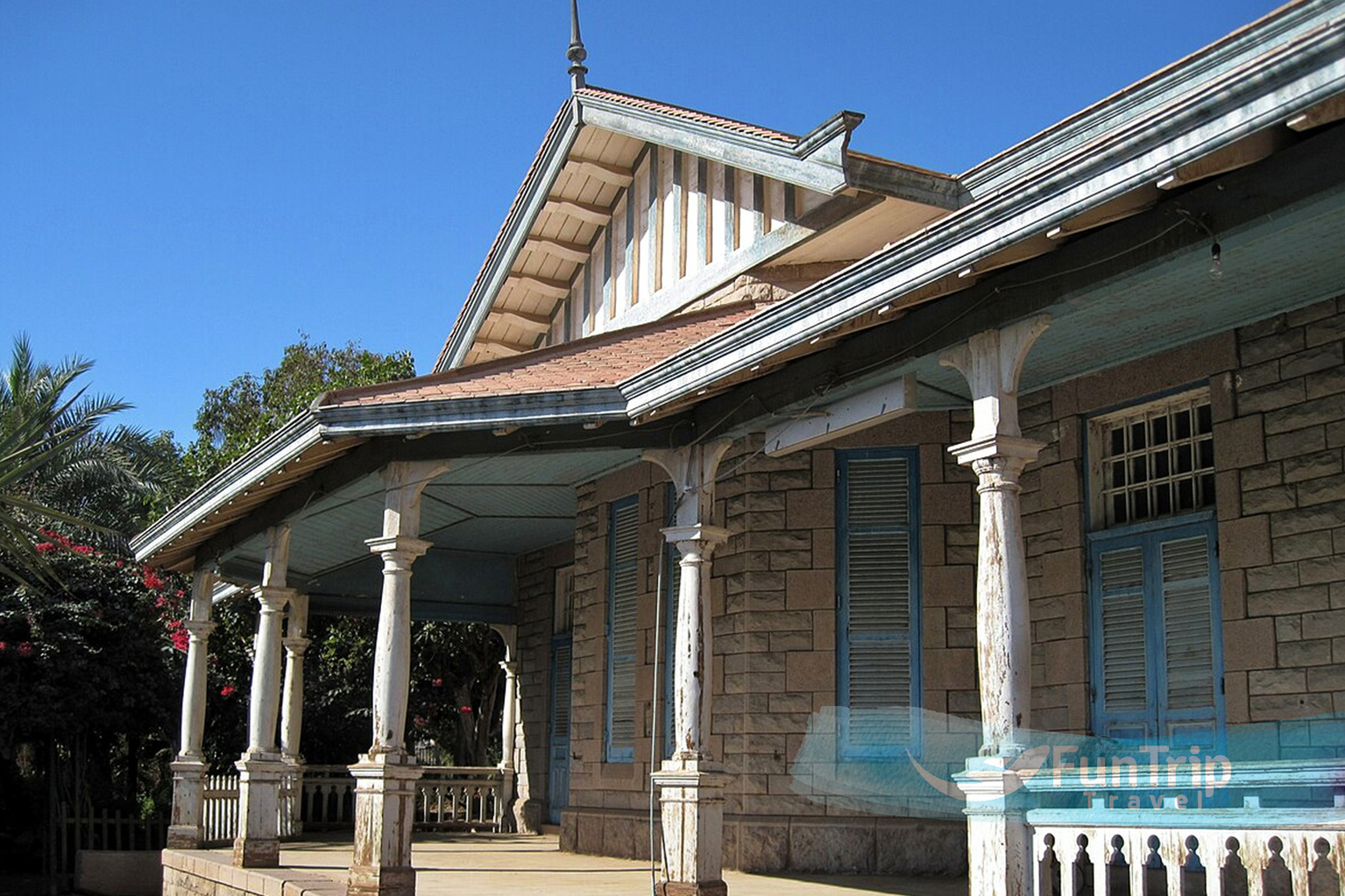
Philae Temple
Water had submerged nearly half of the Island of Philae and all of its remaining monuments for more than half a century. This was caused by the Aswan Dam’s annual flooding. UNESCO’s rescue operations in the 1960s saved these Nubian monuments from destruction. Following that, the temples were completely dismantled and rebuilt on nearby Agilika Island.
The temples’ original orientation was preserved in their reconstruction. Agilika was selected because it is higher in elevation than Philae. However, the workers transformed Agilika into a classic Philae by landscaping and reshaping it to perfection. If you go to the original Philae island, you can still see the metal pylons sticking out of the water in the area facing southern Agilika. The Nectanebo I Kiosk from Dynasty XXX is the oldest Philae monument to have survived. Some evidence suggests that the structure was built during Dynasty XXV, but nothing is certain. The majority of the structures here are Roman or Ptolemaic in nature. After Emperor Justinian closed the temple in 550 A.D., early Christians reused them. The primary temple was built to honor Isis and served as the primary location for the Isis and Hathor cults during the Roman period. After it, no other pagan temple in Egypt was used. Philae is the subject of several legends. The main legend tells of Isis discovering Osiris’ heart in Philae after his brother Seth had murdered him. Every evening, a Sound and Light Show pays tribute to these legends in Philae. They make the show a wonderful experience to witness with the floodlit monuments and the beautiful backdrop. The southern structure of Nectanebo is essentially a hall with columns connecting screen walls. The courtyard features two colonnades on the west and east sides that lead to the original temple pylon. Each column has a different floral capital. Ptolemy XII designed the first pylon, which was decorated in traditional Egyptian style. It also has reliefs depicting the King defeating his enemies and worshipping Isis the Goddess. .
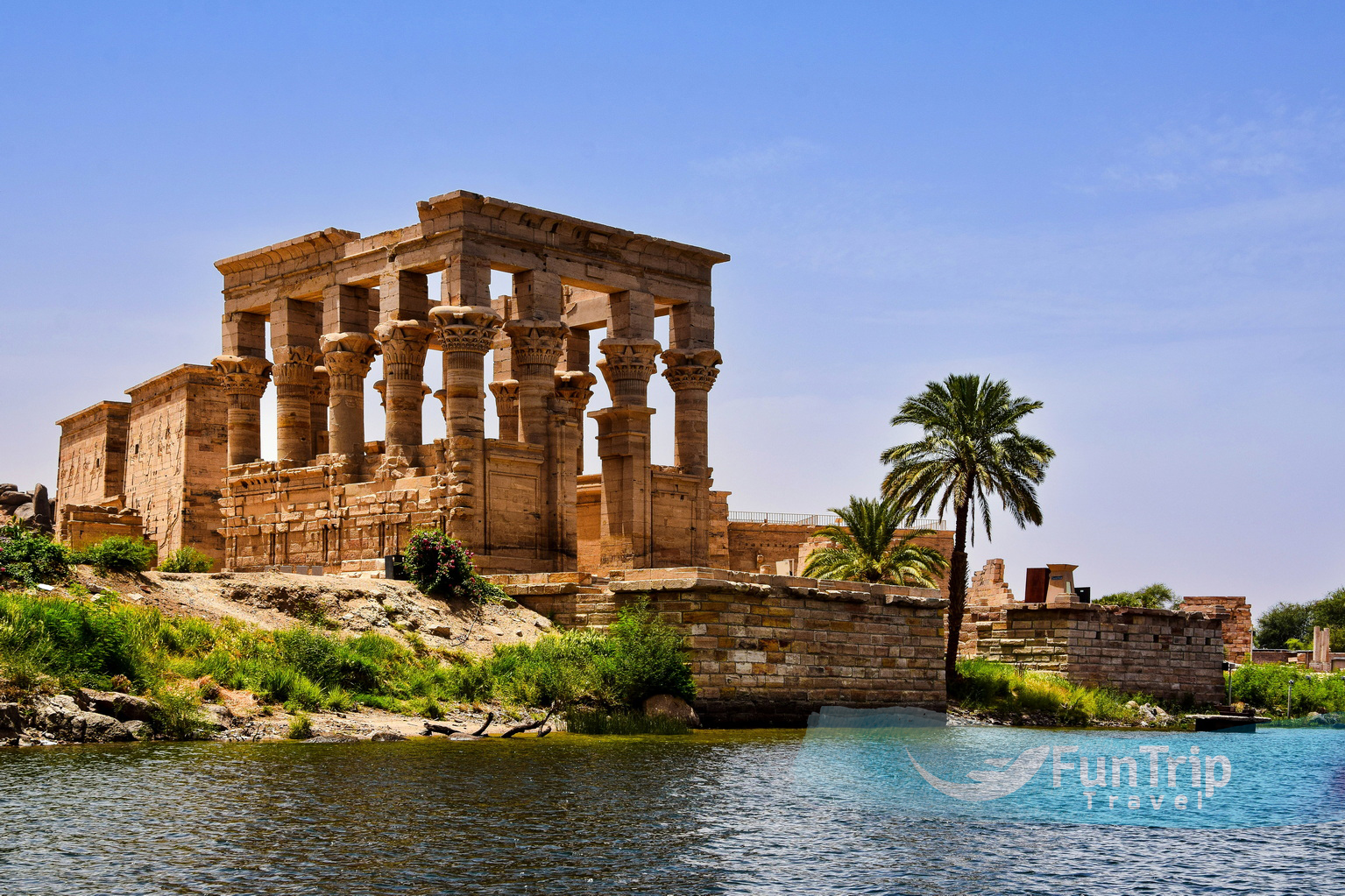 Kalabsha Temple
Kalabsha Temple
Is an impressive Ptolemaic and Roman structure with a layout similar to nearby Philae. The early 19th-century Swiss traveller Burckhardt (who rediscovered Abu Simbel) thought it was ‘amongst the most precious remains of Egyptian antiquity’. The temple was dedicated to the Nubian solar god Merwel, known to the Greeks as Mandulis, and was begun in the late Ptolemaic period and completed during the reign of Emperor Augustus (30 BC-AD 14). It was later converted into a church. From the lake, an impressive stone causeway leads to the temple’s first pylon, beyond which are the colonnaded court and the eight-columned hypostyle hall. Inscriptions on the walls depict various emperors or pharaohs surrounded by gods and goddesses. The sanctuary, which consists of three chambers, is located just beyond the hall. Stairs from one chamber lead to the roof, from which there are spectacular views of Lake Nasser and the High Dam across the hall and court capitals. A well-preserved Nilometer can be found through an inner passageway between the temple and the surrounding wall. The Egyptian government gave Germany the temple’s original outer stone gateway in 1977 as a thank you for assisting in the relocation of this structure. It is now housed in Berlin’s Egyptian Museum. The temples here were relocated from a now-submerged site about 50 km south of Aswan as part of a massive UNESCO effort. The new location is on Lake Nasser’s west bank, just south of the High Dam.

The Granite Quarry
Swenett’s ancient stone quarries had the region’s richest supply of granite and were especially valued for Syenite granite. These quarries supplied the rock for Egypt’s colossal statues, obelisks, and monolithic shrines, including the pyramids. The quarrymen who worked in these quarries 3,000 years ago left traces on the rock faces.
They claimed that the water well reflected the sun’s disc at midday. This assertion is only partially correct; at the summer solstice, the shadow was only 1 of the staff and thus barely discernible, and the northern limb of the Sun’s disc would be almost vertical. At Alexandria, Eratosthenes used this information, along with solstice shadow length measurements, to perform the first recorded calculation of the Earth’s circumference.
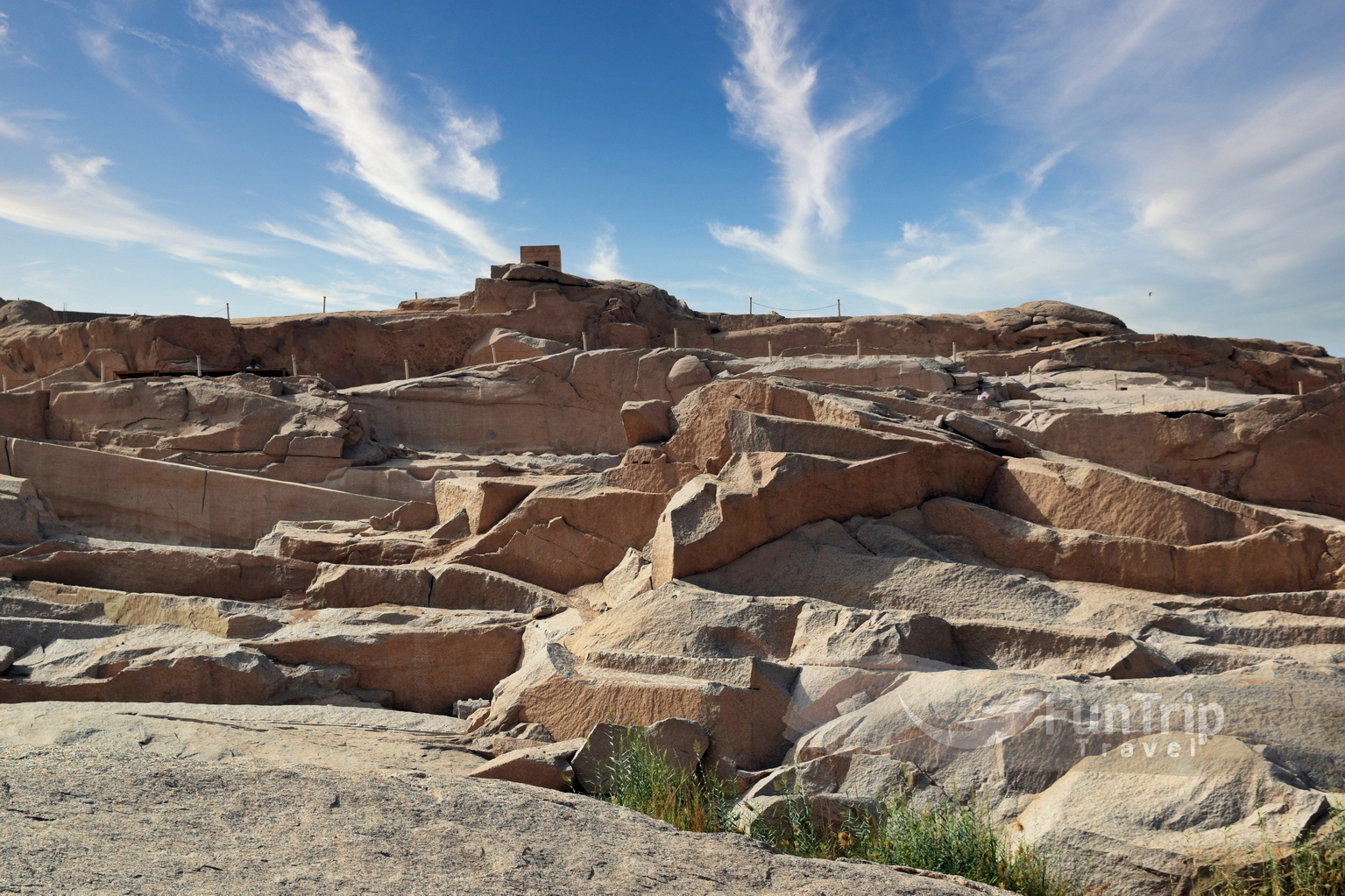
Unfinished Obelisk
Aswan was the source of the finest granite in ancient Egypt, which was used to make statues and embellish temples, pyramids, and obelisks. Although the full construction process is still unknown, the large unfinished obelisk in the Northern Quarries has provided valuable insight into how these monuments were created. Except for the inscriptions, three sides of the nearly 42m long shaft were completed. The finished obelisk would have been the heaviest piece of stone ever fashioned by the Egyptians, weighing 1168 tons.
However, a flaw appeared late in the process, and it now lies where the disgruntled stonemasons abandoned it, still partially attached to the parent rock. Upon entering the quarry, steps lead down into the obelisk pit, where ancient pictographs of dolphins, ostriches, and flamingos are thought to have been painted by quarry workers. The Northern Quarries are about 1.5 km from town, directly across from the Fatimid Cemetery. The ancient Western Quarry, located in the desert to the west of the Tombs of the Nobles, was where stone for many ancient monuments, possibly including the Colossi of Memnon, was quarried. Before it was abandoned, a large unfinished obelisk made for Seti I (1294-1279 BC) was decorated on three sides of its apex. The ancient quarry face and marks are clearly visible near the obelisk, as are the tracks on which the massive blocks were dragged down to the Nile.
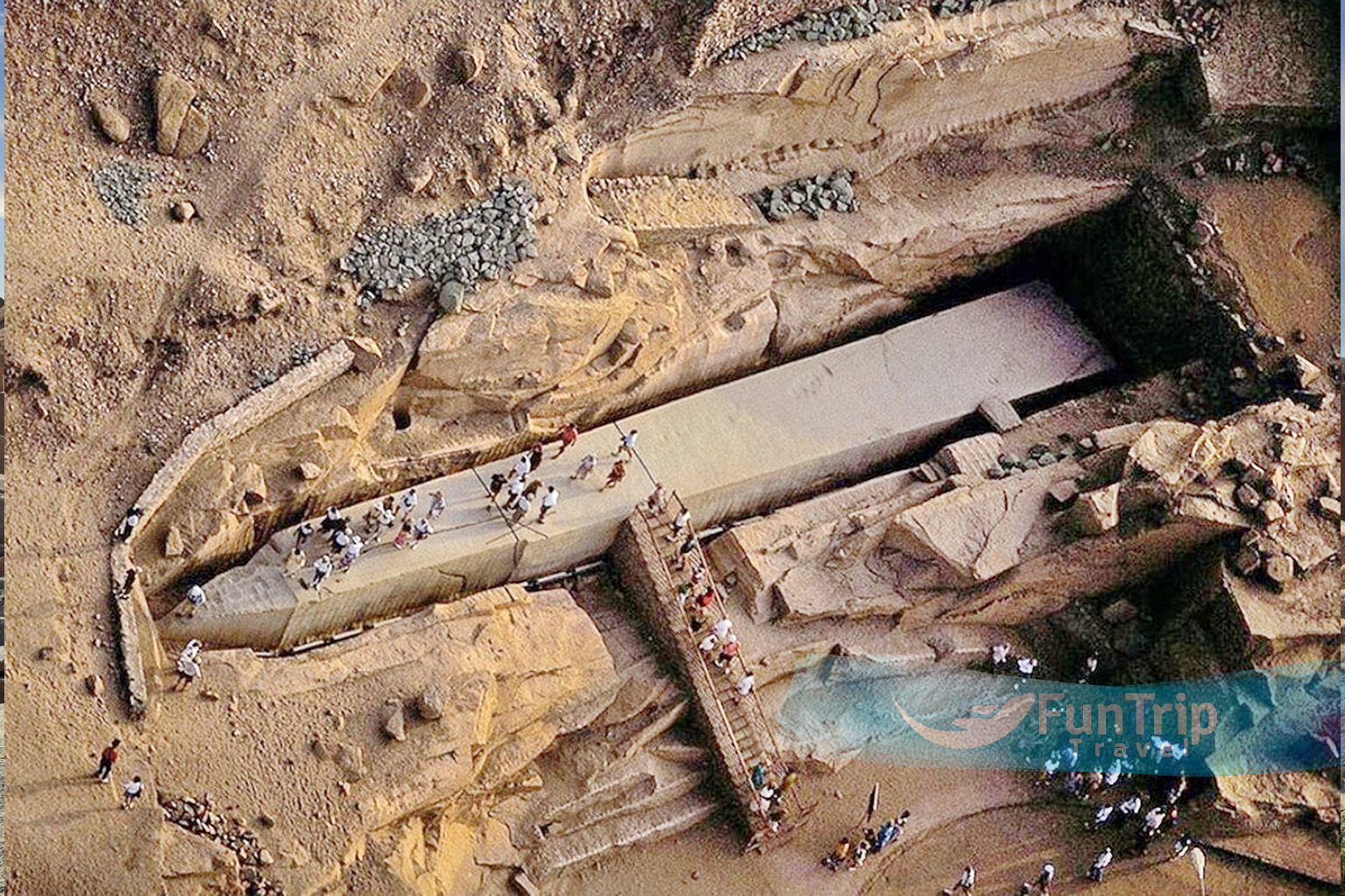
Tombs of the Nobles
The high cliffs opposite Aswan, just north of Kitchener’s Island, are peppered with the tombs of ancient Elephantine Island’s governors, Keepers of the Gate of the South, and other dignitaries. The Tombs of the Nobles are still being excavated; significant discoveries were made in 2014 and 2017. Six ornate tombs are now open to the public.
The tombs date from the Old and Middle Kingdoms and have a straightforward layout, with an entrance hall, a pillared room, and a corridor leading to the burial chamber. From the ferry dock, a set of stairs cut diagonally across the hill leads up to the tombs.
The tombs of father and son governors Mekhu and Sabni (tomb numbers 25 and 26) date from the long reign of 6th-dynasty Pharaoh Pepi II (2278–2184 BC). Sabni’s tomb reliefs depict how he led his army into Nubia to punish the tribe responsible for killing his father during a previous military campaign and to retrieve his father’s body. Pepi II sent him his own royal embalmers and professional mourners upon his return to demonstrate the importance he placed on the keepers of the southern frontier. Several reliefs in Sabni’s tomb still have their original colors, and there are some lovely hunting and fishing scenes in the pillared hall depicting him with his daughters. Sarenput was the local governor and overseer of the priesthood of Satet and Khnum under Pharaoh Amenemhat II of the 12th dynasty (1922–1878 BC). Sarenput II’s tomb (number 31) is one of the most beautiful and well-preserved, with vibrant colours. A six-pillared entrance chamber leads into a corridor with six niches containing Sarenput statues. The burial chamber has four columns and a niche, as well as wall paintings of Sarenput with his wife (on the right) and mother (on the left), as well as hunting and fishing scenes. The tomb of Harkhuf (number 34), governor of the south during Pepi II’s reign, is sparsely decorated, save for three remarkable hieroglyphic texts about his three trading expeditions into Central Africa, which are located to the right of the entrance. Pepi II, then only eight years old, advises Harkhuf to take extra care of the ‘dancing pygmy’ he acquired on his travels, as the pharaoh was eager to see him in Memphis. ‘More than the gifts of Sinai or Punt, my majesty desires to see this pygmy,’ Harkhuf writes. The tiny hieroglyph figure of the pygmy appears several times in the text. During Pepi II’s reign, Hekaib, also known as Pepinakht, was in charge of foreign soldiers. He was dispatched to quell rebellions in both Nubia and Palestine, and was even deified after his death, as evidenced by the small Hekaib shrine built on Elephantine Island during the Middle Kingdom (c 1900 BC). Fine reliefs depict fighting bulls and hunting scenes inside Hekaib’s tomb (number 35). The court of Sarenput I’s tomb (number 36), grandfather of Sarenput II and governor during Sesostris I’s 12th-dynasty reign (1965-1920 BC), contains the remains of six relief-decorated pillars. Sarenput is shown being followed by his dogs and sandal-bearer, his flower-bearing harem, his wife, and his three sons on either side of the entrance.
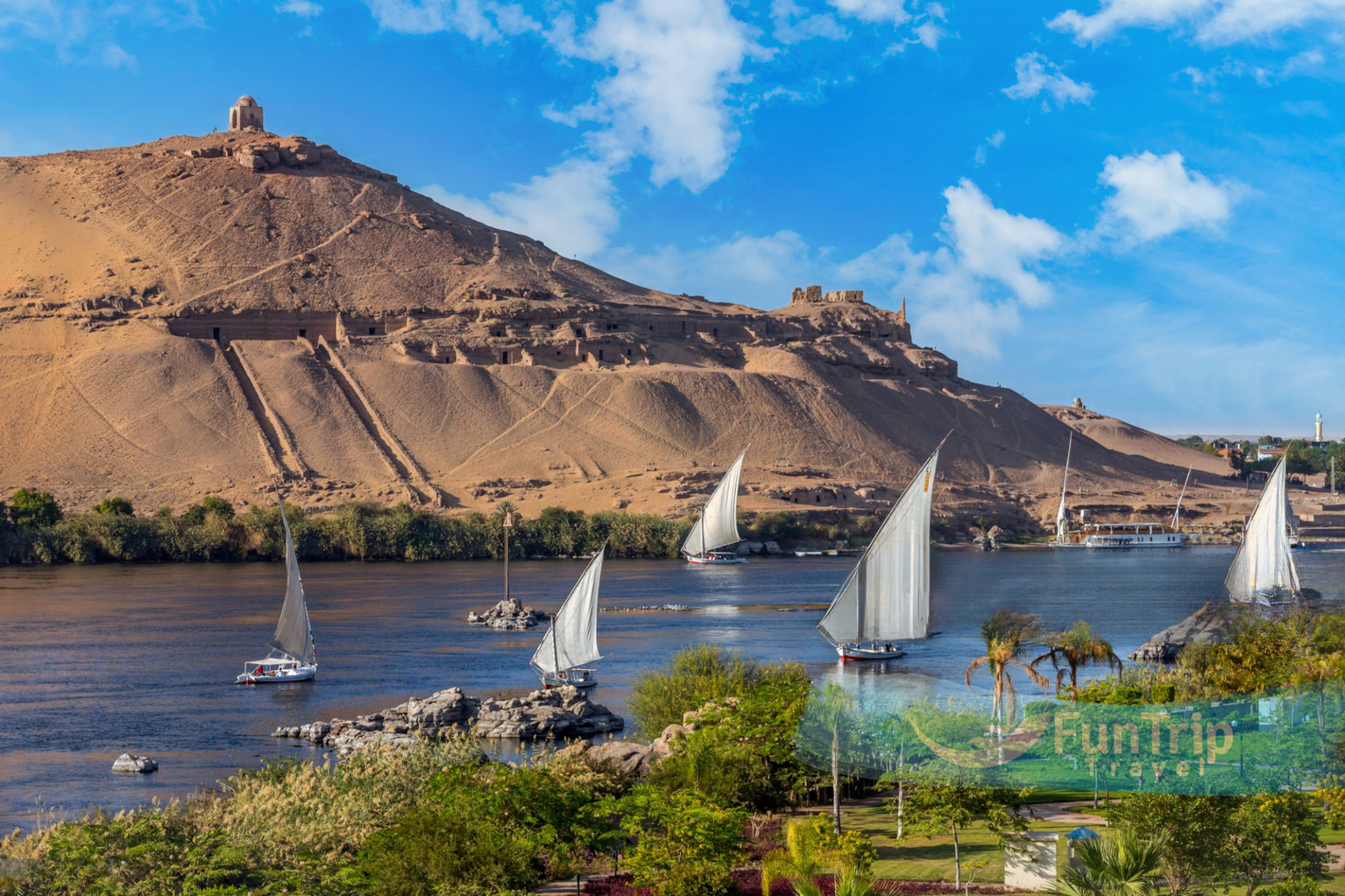
Fekra Cultural Centre
Fekra is a farm on 40,000 square meters of land on the lake between the old dam and the High Dam, overlooking Philae Island. The Fekra Cultural Centre – fekra means thought or idea in Arabic – is an intriguing project of artists from around the world that aims to support Nubian and Upper Egyptian artists while also promoting international cultural exchange through artistic events and workshops. It’s a magical place because of its energy and beautiful setting. A Nubian-style mud-brick house right on the lake, it’s perfectly peaceful and a great place for swimming. It has midrange accommodations for 12 people as well as a few extra Bedouin tents with shared bathrooms.
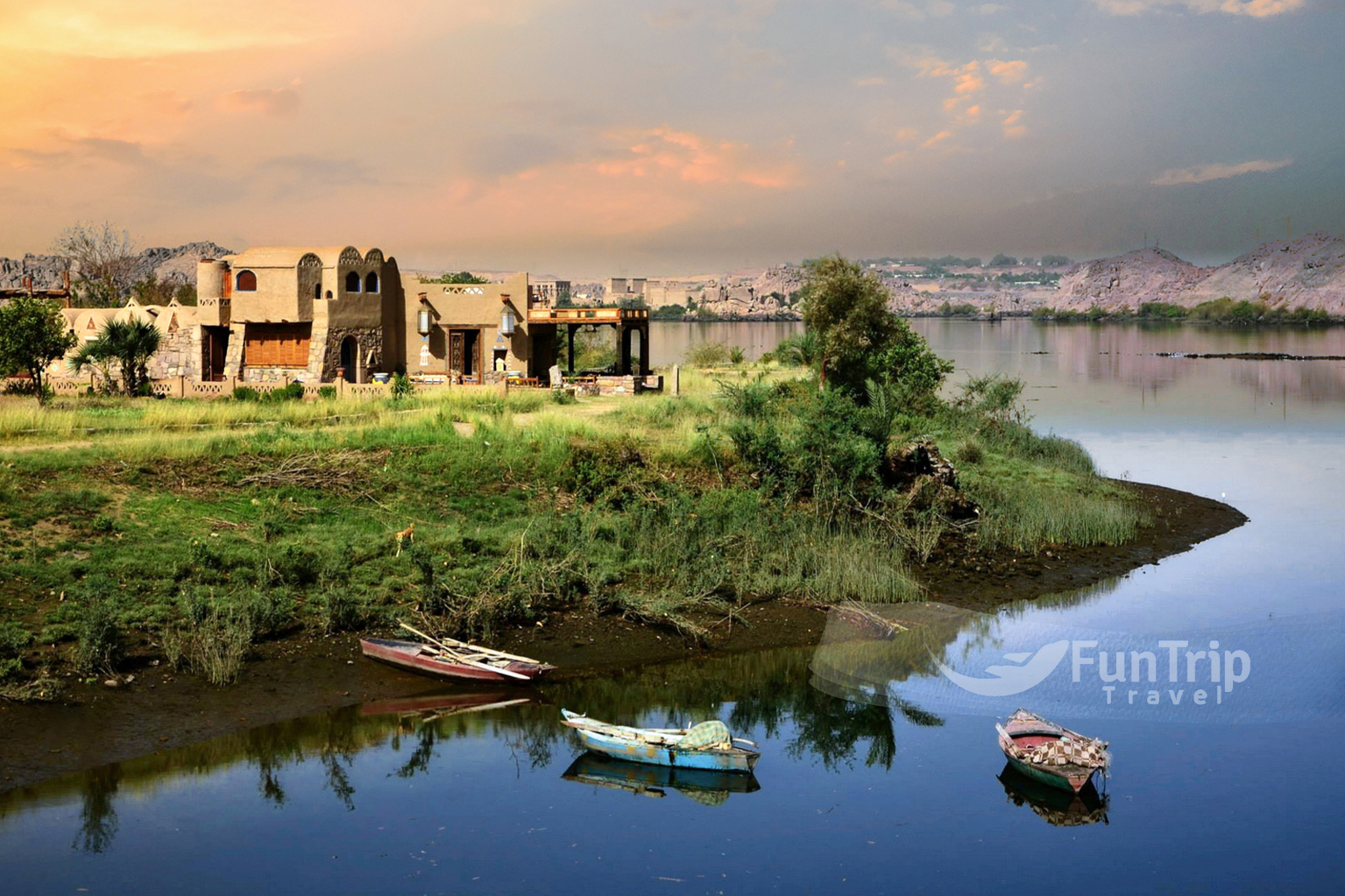
Monastery of St Simeon
The fortress-like St Simeon Monastery, built in the seventh century, was originally dedicated to the local saint Anba Hedra, who renounced the world on his wedding day. It was reconstructed in the tenth century. The monastery was built on two levels, one of stone and one of mud brick, surrounded by 10m-high walls and surrounded by desert sands. The monastery may have housed up to 1000 monks at its peak, but it was partially destroyed by Saladin’s (Salah Ad Din) troops in 1173. There are remnants of frescoes in the basilica. The mastaba (bench) beds remain in the cells. The last room on the right has graffiti from Muslim pilgrims who stayed here on their way to Mecca, and while most of the monastery is in ruins, the fortified walls and many parts of it are still quite impressive.
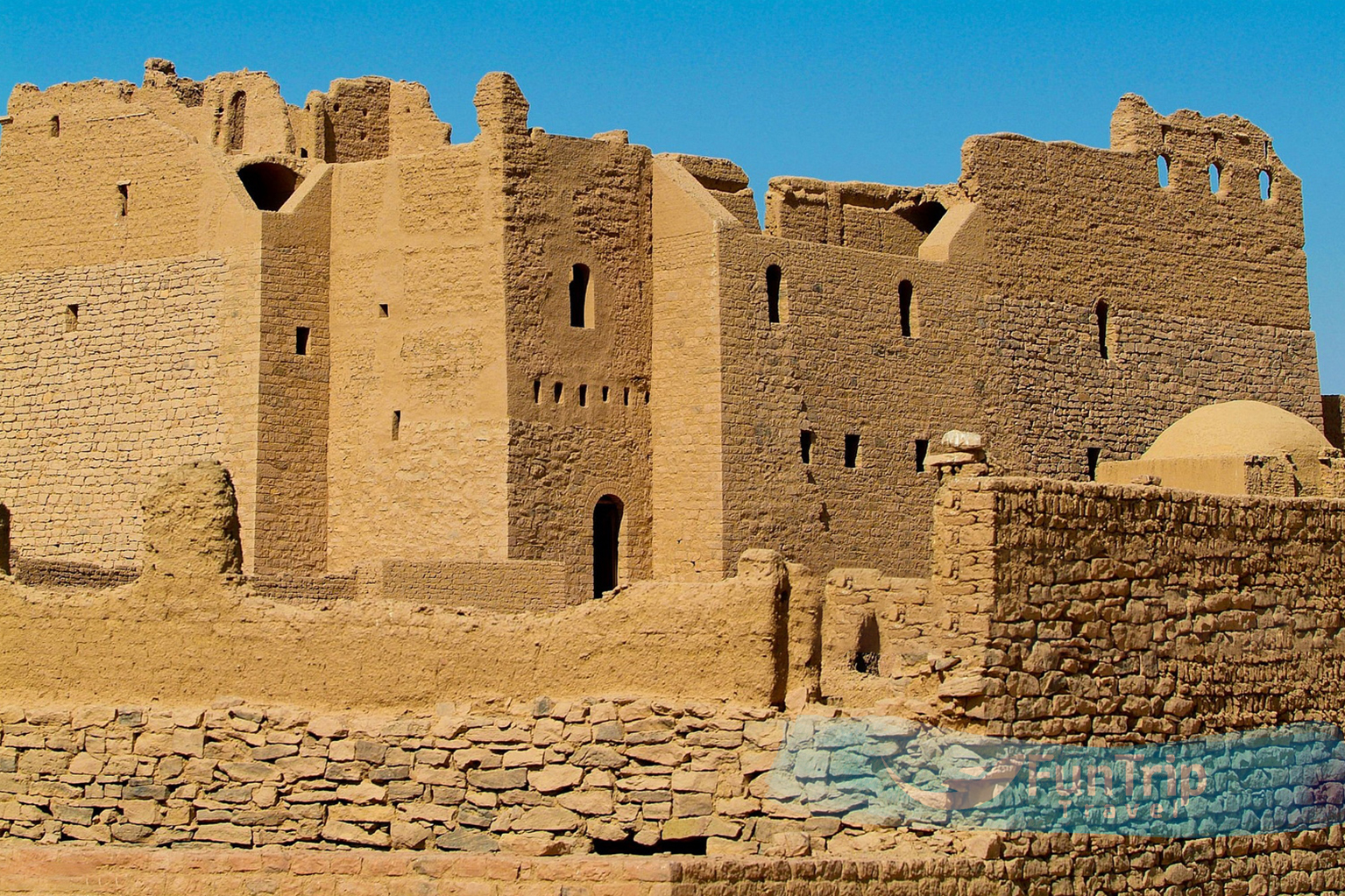
The Souq of Aswan
Every Egyptian city has a neighborhood market. The Aswan Market (The Souq in Arabic) on the other hand, is quite unique in that it sells a diverse range of goods and products. The city itself was regarded as a major trade hub for caravans travelling between Africa and the Nile Valley. Aswan market welcomes commercial caravans carrying cloth, spices, and other assorted goods from various African regions. Most Aswan tour packages include a visit to the market, as the town is well known for selling various disease curing spices and great herbs for improving the general health of all residents. Pottery, oriental dresses and outfits, sculptures, scarves, perfume, spice, and roughly carved copies of Pharaonic statues are among the other amazing items. Nubian talismans for good luck, colorful Nubian baskets and skullcaps, Sudanese swords, African masks, and enormous stuffed crocodiles and desert creatures are available from traders.
The market in Aswan also sells Nubian products, souvenirs, and various gift items. Along with the River Nile activities, strolling through the Aswan market and watching the traders bargain and transact business is an interesting addition to the Aswan tour.

The Aswan Dams
Completed in 1902, was a feat of engineering for its time and the world’s largest dam, measuring 2441m across, 50m high, and 30m wide. The road that runs across the top of the dam (which you’ll take if heading to the airport or Abu Simbel) has excellent Nile views, though it’s not an attraction in and of itself. The Aswan Dam project began at the end of the nineteenth century, when Egypt’s rapidly growing population made it necessary to cultivate more agricultural land. This would only be possible by regulating the Nile’s flow, which would also prevent the river from bursting its banks during the flood. Sir William Willcocks, a British engineer, began construction above the First Cataract in 1898, with the dam structure made almost entirely of Aswan granite. It was raised twice to meet demand, not only to increase the area of cultivable land but also to provide hydroelectric power. Today the old dam generates hydroelectricity only for a nearby factory producing fertilizers. The opening of the second Aswan High Dam is only six km south of the old dam or the Aswan Dam. It is a massive water dam built with the assistance of the Soviet Union 1960-1970 during the rule of Gamal Abdel Nasser, the former Egyptian president. The construction of the High Dam is regarded as one of Egypt’s most significant achievements in modern times. The High Dam has greatly benefited Egypt by allowing the Egyptians to control Nile floods. It is also still regarded as Egypt’s first and most important source of electricity.
The dam has a length of 3600 meters, the width of the base is 980 meters, the width of the top is 40 meters, and its height is around 111 meters. The body of the High Dam is 43 million cubic meters of cement, iron, and many other materials.
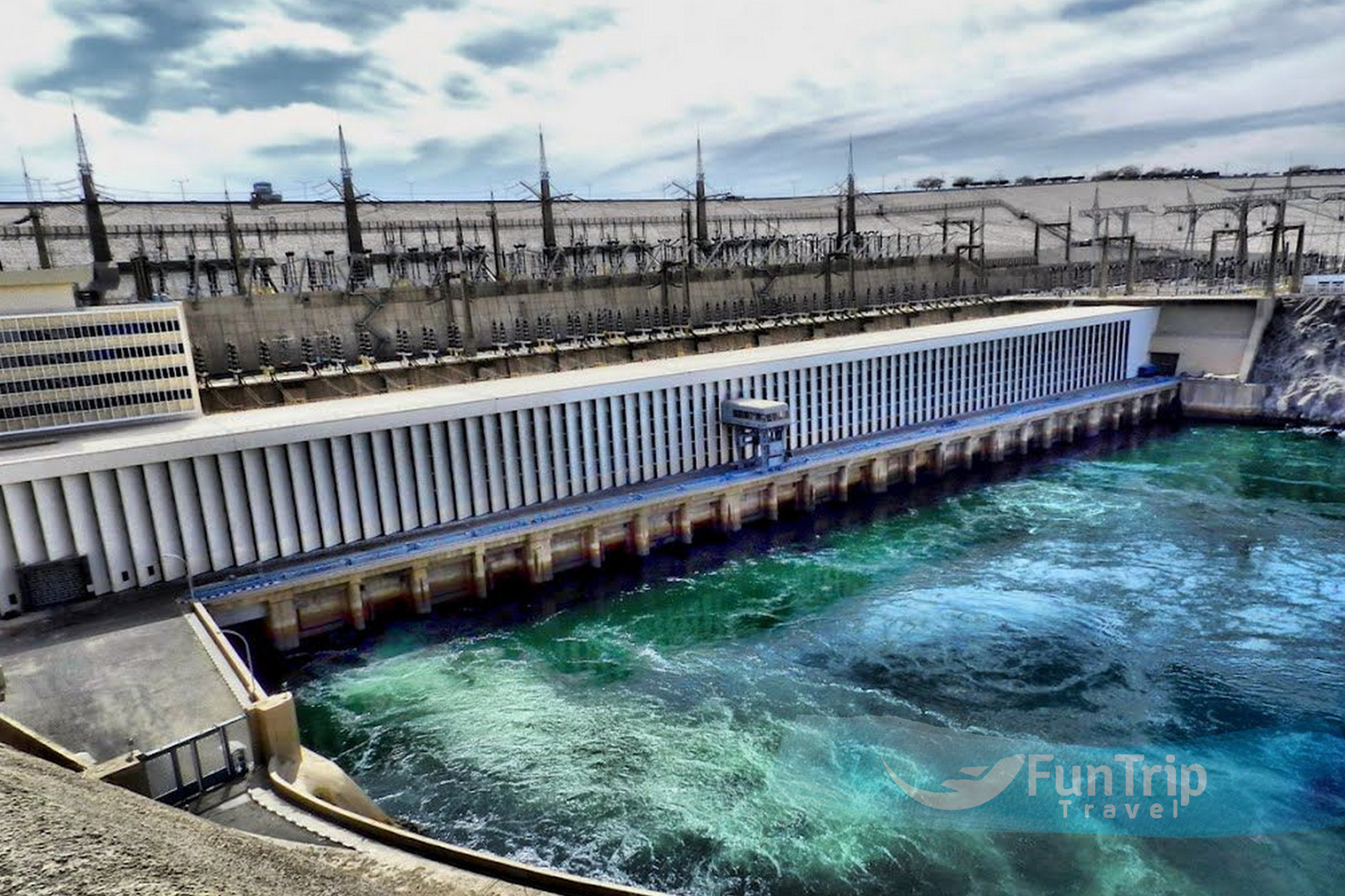
Bird Watching
Bird watchers have long flocked to Aswan in the winter, but being on the Nile early in the morning, gliding along the edge of the islands, watching birds and hearing how they fit into ancient Egyptian history or Nubian traditions, has a much wider appeal, even to non-twitchers. Our local guides are known as the ‘Birdmen of Aswan,’ and no bird escapes their attention.
We’ve been taking twitchers and documentary makers out for many years, but he’s also happy to take amateurs out in his small speed boat, which glides into the channels between the islands, pointing out the vegetation; sunbirds; hoopoes; purple, squacco, striated, and night herons; pied kingfishers; little and cattle egrets; redshanks; and many other birds.
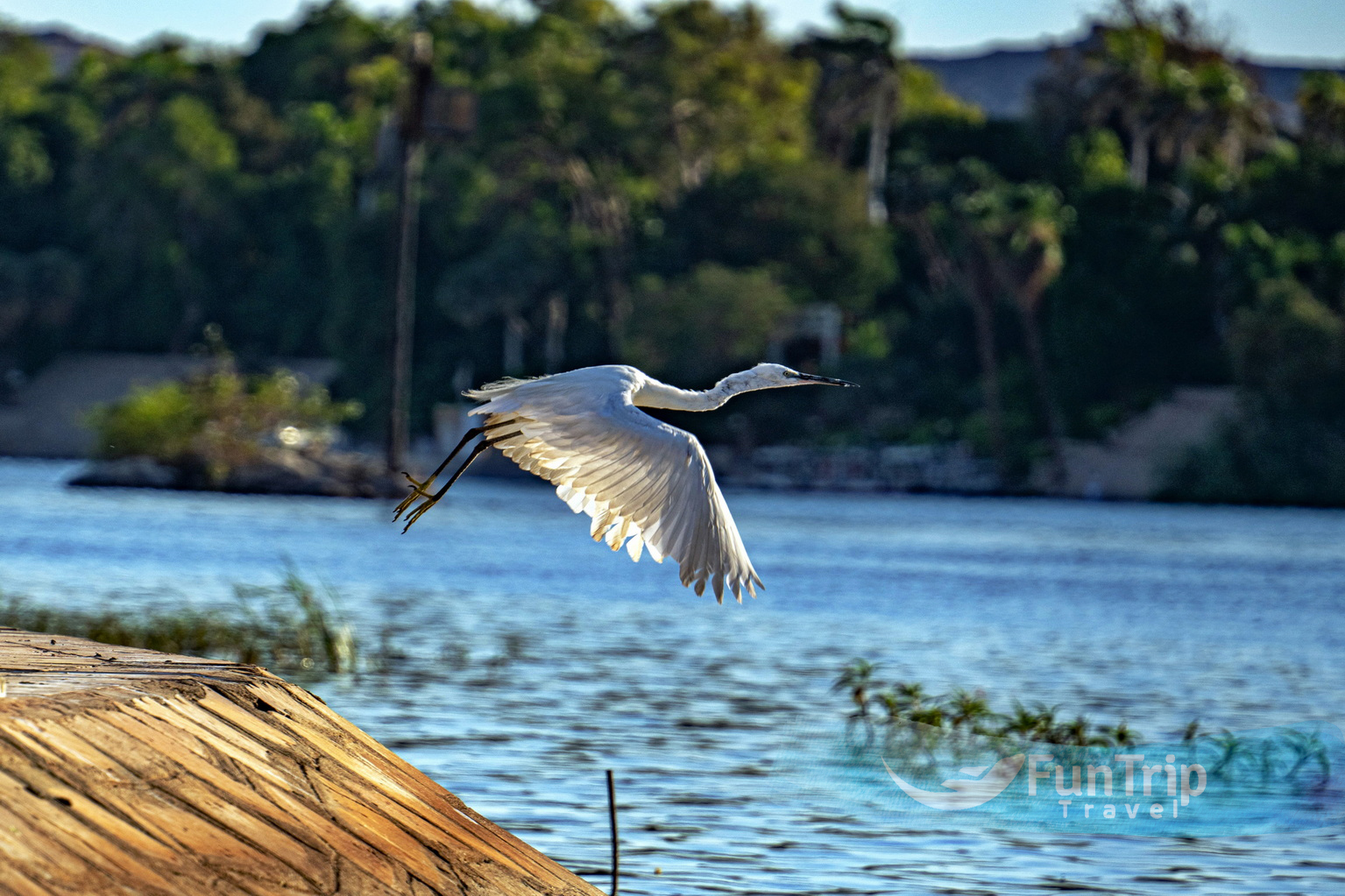
Heisa Island
Heisa is a small island east of Aswan that is squeezed between the Philae Temple and the Nile River Dam. It is one of the oldest Nubian islands and the only one that still exists today. Because the town is located on high ground, visiting it is an adventure. Heisa’s first crisis occurred in 1902, when most of the farmland was flooded as a result of the construction of a small dam.
Years later, when the Aswan reservoir and dam were built in the 1930s, many of the residents of the neighboring islands were forced to flee their homes due to the impending flooding. The Heisa community was one of the few that did not relocate, instead choosing higher ground. However, the island was still flooded, taking with it the majority of their farmlands. The island is named after Egyptian king “Hess” of the seventh dynasty. Heisa was once a burial ground for priests who worked on the island as well as Philae. It was also a natural source of wood and stones, which were later transported across the Nile to become the Saqqara pyramid. The bright, vivid colors that decorate all of the houses in Heisa quickly change one’s mood. It is a masterpiece created by combining simple art and architecture. Furthermore, as you ascend, the air smells different, cleaner, and free of the hustle and bustle of modern civilization. In the eyes of the visitor to Heisa, life is simple: one eats, sleeps, and lives in nature. The view distracts the island’s visitors from their daily routines in the morning, and the stars dazzle at night. Even the hotels are simple camps or lodges that are eco-friendly and focus on providing a view of crystal clear skies and beautiful water.
